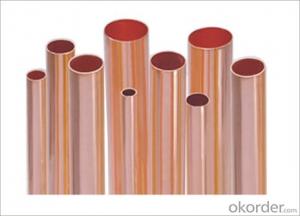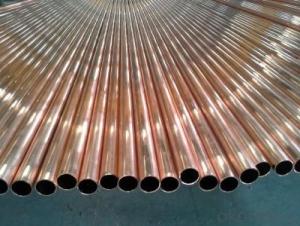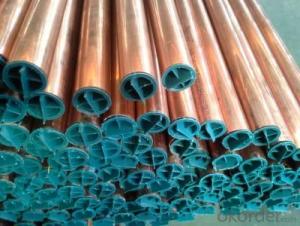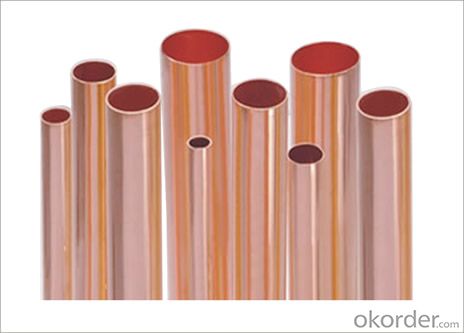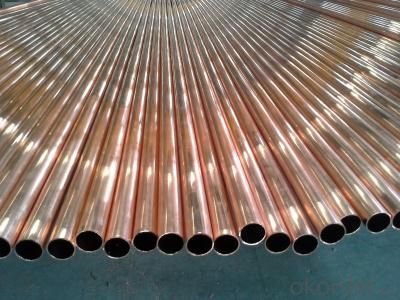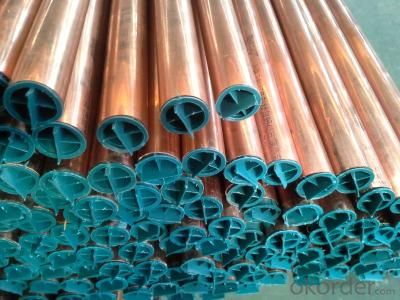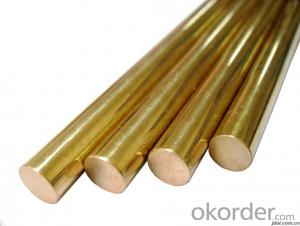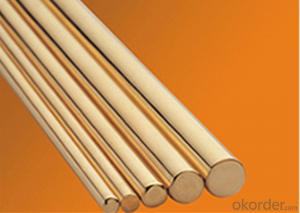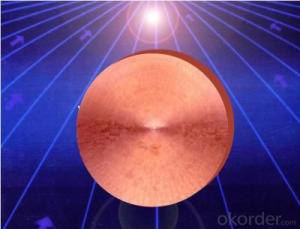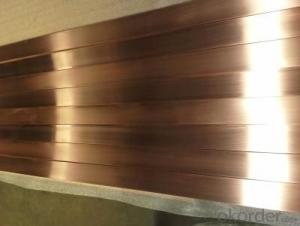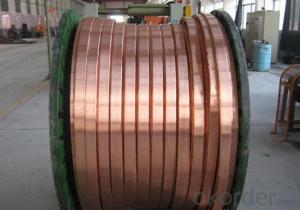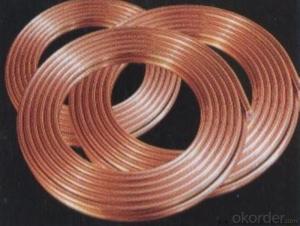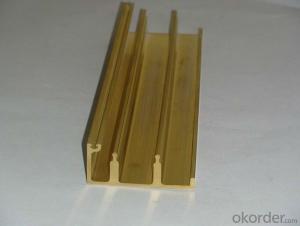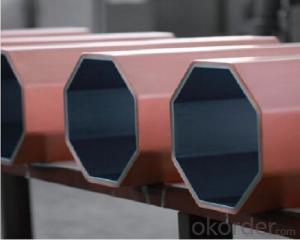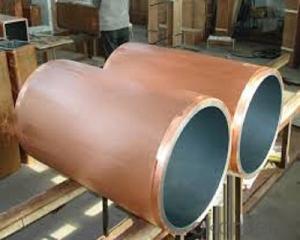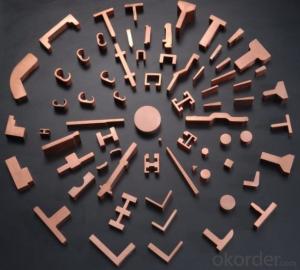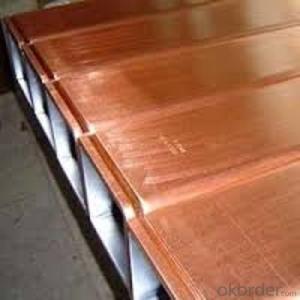Refrigeration Copper Pipe R410A for Refrigeration System
- Loading Port:
- Shanghai
- Payment Terms:
- TT OR LC
- Min Order Qty:
- 500 kg
- Supply Capability:
- 10000 kg/month
OKorder Service Pledge
OKorder Financial Service
You Might Also Like
Refrigerant Copper Pipe Type R410A
Model: TP2、TU1、TU2、T2
Application:
Primarily applied in household and commercial central air conditioning system; pressure resistant product made by large water seal extruder through degrease process, without residual oil and with low dust load, suitable for refrigeration systems using new refrigerant
Type Specifications: TP2, TU1, TU2, T2
Primarily applied in household and commercial central air conditioning system; pressure resistant product made by large water seal extruder through degrease process, without residual oil and with low dust load, suitable for refrigeration systems using new refrigerant
Specifications:
Item | air conditioner copper pipe |
Type | straight copper pipe,pancake coil copper pipe,capillary copper pipe |
Standard | GB/T1527-2006,JIS H3300-2006,ASTM B75M,ASTMB42,ASTMB111,ASTMB395, ASTM B359,ASTM B188,ASTM B698,ASTM B640,etc |
Material | C10100,C10200,C10300,C10400,C10500,C10700,C10800,C10910,C10920, C10930,C11000,C11300,C11400,C11500,C11600,C12000,C12200,C12300, C12500,C14200,C14420,C14500,C14510,C14520,C14530,C17200,C19200, C21000,C23000,C26000,C27000,C27400,C28000,C33000,C33200,C37000, C44300,C44400,C44500,C60800,C63020,C65500,C68700,C70400,C70620, C71000,C71500,C71520,C71640,C72200,etc |
Shape | Round,Square,Rectangular,Oval,half-round |
Outside diameter | 4.76-28.58mm |
Wall thickness | 0.4-1.5mm |
Length | 1m,2m,3m,6m,or as required |
Hardness | 1/16 hard,1/8 hard,3/8 hard,1/4 hard,1/2hard,full hard,soft,. |
Surface | mill,polished,bright,oiled,hair line,brush,mirror,sand blast,or as required |
Price Term | Ex-Work,FOB,CNF,CFR,CIF etc |
Payment Terms | TT,L/C etc |
Export to | Singapore,Indonesia,Ukraine,Korea,Thailand,Viet Nam,Saudi Arabia,Brazil,Spain,Canada, USA,Egypt,Iran,India,Kuwait,Dubai,Oman,Kuwait,Peru,Mexico,Iraq,Russia,Malaysia,etc |
MOQ | 2 tons |
Package | Standard export package ,or as required. |
Application | Copper pipe have strong, corrosion resistant properties, and become a modern contractor in all of commodity house pipes, heating, cooling water piping installation of choice |
Contact | If you have any question ,please feel free to contact me we are sure your inquiry or requirements will get prompt attention |
Production Equipment
750-1500kg main frequency induction copper melting furnace, 80MN water seal extruder, LG60 high speed two-roll cold pilger mill, straight-line wire-drawing machine, copper tube/pipe straightener, polisher, 84′ copper coil winding machine, straightening-cutting & pancake coiling machine, thermoplastic packaging machine, 1.2T continuous bright annealing furnace.

80MN extruder

Continuous bright annealing furnace
Testing Devices
spectrum analyzer, atomic absorption analyzer, spectrophotometry, analytical balances, metallurgical microscope, eddy current flaw detector, metal tensile testing machine, eddy conductivity instrument.

Hardness tester

Spectrum analyzer

Metallurgical microscope

Metal tensile testing machine

Atomic absorption analyzer
Process
refined copper — smelting & casting — extrusion — rolling — drawing — straightening-cutting/forming of pancake coil — bright annealing — packaging — finished goods.
Standards
GB/T 1527-2006 Drawn tube of copper and copper alloys
GB/T 16866-2006 Dimensions and tolerances of copper and copper alloy seamless tubes
GB/T 4423-2007 Copper and copper-alloy cold-drawn rod and bar
GB/T 5231-2001 Wrought copper and copper alloys chemical composition limits and forms of wrought products
GB/T 5585.1-2005 Copper or aluminium and its alloy bus bars for electrical purposes—Part 1:Copper andcopper alloy bus bars
GB/T 17791-2007 Seamless copper tube for air conditioner and refrigeration equipment
GB/T 19850-2005 The seamless round copper tubes for electrical purposes
GB/T 26024-2010 Seamless copper and copper alloys tube for valves on air-conditioning and refrigeration system
ASTM B280-2008 Standard Specification for Seamless Copper Tube for Air Conditioning and Refrigeration Field Service
EN 12735-1:2001 Copper and copper alloys Seamless,round copper tubes for air-conditioning and refrigeration Part 1:Tubes for piping systems
EN 12735-2:2001 Copper and copper alloy – seamless round copper tube/pipe for air-conditioning and refrigeration system – for equipment
JIS H3300-2009 Seamless copper and copper alloy tube/pipe
- Q: Will we ever run out of copper? I know that it is able to be recycle but there is a finite amountso plz give a scientific answer and write down the source if possible.
- Wikipedia says that it will run out in 25 years (2008)!
- Q: (in terms an eighth grader would understand please)thanks!!
- Copper, as a metal never occurs in its pure state, but always as a compound with another atom or atoms. And copper sulfide is one of the forms that copper is found naturally, so treating it will provide pure copper metal.
- Q: We're getting a water filter system put in and the plumber is recommending we get rid of the copper supply line and go with PVC. I'm concerned about phthalates in the PVC especially since the water is acidic. (ph of about 6.7) I'd rather not be drinking plastic, so I was wondering should I stay with the copper pipe, go with the PVC, or go with polypropylene pipe such as Aquatherm pipe (aquathermpipe )
- I believe the copper will breakdown quicker with the acidic water and old copper may have lead solder. I would say the aquathermpipe is best but PVC would be my choice do to cost and break down composition. your water is acidic but not so that it will do what your brain is telling you acidic means. If this makes sense.
- Q: So my class recently performed a lab wherein we placed a copper wire in a solution of silver nitrate. In a few days, silver formed as a precipitate on the copper (but easily fell off).Any ideas on whether copper or silver nitrate was the limting reagent?Thanks so much,Daniel
- Was there still some copper left? Seeing as the silver fell off the copper wire, it seems there was still plenty of unreacted copper left over. Which would suggest that the silver nitrate solution all got used up. However, if the silver coating completely covered the copper, and the copper underneath was unable to make contact with the solution, it's possible that there was still some silver nitrate left. But it doesn't mean the copper was the limiting reagent, only that some of the copper remained inaccessible to the solution. If there was copper wire left over at the end, the copper was in excess. To truly make the silver in excess, put a tiny pinch of copper powder in to the silver nitrate solution. you could always test for silver ions by adding a drop of HCl. Any silver will form a white precipitate of silver chloride.
- Q: We done some copper reduction experiments. But we need to find out how it was used in ancient times. . How the process was used? What did ancient people use it for? Really need this thank you!
- For nearly 5000 years copper was the only metal known to man. Humans first used copper about 10,000 years ago. A copper pendant discovered in Northern Iraq is thought to date back to around 8700 BC. Prehistoric man probably used copper for weapon making. Ancient Egyptians too seemed to have appreciated the corrosion resistance of the metal. They used copper bands and nails in ship building and copper pipes were used to convey water. Some of these artifacts survive today in good condition. An estimate of the total Egyptian copper output over 1500 years is 10,000 tons. Probably the earliest copper was produced by rocks like malachite around fires being reduced to copper by the carbon. Since copper is quite malleable and soft, it could be shaped by primitive tools like hammers.
- Q: im making a xylophone with copper piping and i need to know if there is resonance when i hit the copper piping with a mallet
- yess it will im not shure how much but i would sugest trying some thing diffrent like pluming pipe befor trying copper
- Q: I bought an antique copper hip flask from Portebello market (London), when I washed it out with water loads of grime came out. Is it safe to drink hard liquor from it or will I get some sort of copper poisining? I've washed it out with boiling water and fairy antibacterial washing up liquid, what would you recomend I do? thanks in advance :D xx
- Is the flask lined with another metal other than copper, IF NOT, don't use it as you could get cooper poisoning...yes I am serious....If it is lined then use a vinegar,soap &water solution and let it set for a few hours to a day, then rinse it out and clean well, repeat if necessary,if possible use a bottle brush to help get inside.... Be CAREFUL if the flask is not lined, adding liquor (whiskey)is similar to adding bleach to it and drinking it as the alcohol will have an adverse affect on the copper. IF needed contact a copper smith. ntact PAUL REVERE COOKWARE as they use a lot of copper in their products for advice.
- Q: My contractor just did this. He says the 3/4 pipe will enable us to store more hot water in pipes. Pipe coming into house from main is only 1/2. Any thoughts??
- your water pressure will go down. larger pipe to smaller pipe,pressure goes up. smaller pipe to larger pipe, pressure goes down. plus 3/4 pipe cost more.
Send your message to us
Refrigeration Copper Pipe R410A for Refrigeration System
- Loading Port:
- Shanghai
- Payment Terms:
- TT OR LC
- Min Order Qty:
- 500 kg
- Supply Capability:
- 10000 kg/month
OKorder Service Pledge
OKorder Financial Service
Similar products
Hot products
Hot Searches
Related keywords
